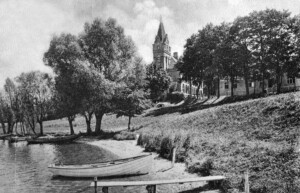Read in another language:
The history of our town’s mill began in 1804, i.e. more than 200 years ago. Such a date is specified in the sale documents of the plot of land on which the mill was built. Of course, in the history of our town’s mills, this date is conventional and indicates a specific event, place and people. In 1559 in the town’s plan, even before the construction of the mill, the place where this structure should be built was marked in the projected city. In the archived plan of Marggrabowa (now Olecko), drawn up in the middle of the 18th century, a mill building was marked on the left bank of the Lego river. However, we can only review the history of this place starting from 1804. It was passed from hand to hand: inherited, sold, shared. New names, relatives, tenants, shareholders and co-owners are found in the documents. Among them were representatives of the best, most entrepreneurial families of the town, such as Konietzko or Czygan. In addition, this place has always been important for both life and economy of the town located on the river Lego. From preserved materials, e.g. according to the article in the newspaper “Treuburger Zeitung” No. 251 in 1941, it is known that 40 workers worked there then, including eight foreigners, so it is easy to understand that it was forced labor. The mill not only produced flour from grain, but also traded in flour, grain, seeds, feed, fertilizers, potatoes and even fuel.
The Konietzko family, which owned the mill since 1888, finished building a new headquarters in 1895. A large building with a Neo-Renaissance style front part (east and south facades) was built along Grünwald Street (former Deutsche Str.) and Müller Street (Müller Gasse) and had a large industrial part on the bank of the Lego. The representative concept – the ornate bossage parterre and the more restrained, elegant second floor – reflects the characteristics of the Renaissance palace. Both (south and east) facades have five axes and are connected by a tripartite tower, partially embedded in the base block, raised one story above the gable roofs and completed by a hexagonal dome with a small pointed cupola at the top. The window openings on the ground floor are arched, on the second floor they are straight, with closed panels, gently curved in an arc and forming cornices.
The mill suffered a lot during the World War I. When it was rebuilt, it was turned into a company that operated until the end of 1944. In January 1945, the Russians came to the town. Frontline battles took place on the sidelines, a Soviet army unit entered an empty town. Almost all the previous inhabitants abandoned the town, leaving it to the will of the war, the enemy and looters. In the spring, life slowly started to get back on track. The mill was needed, but destroyed, equipment looted. It became a warehouse for mines found in the area. It needed to be rebuilt and equipped. Soon, it started grinding grain again. The mill company operates to this day. However, it failed to restore its status as one of the largest companies in the town and the surrounding area.



